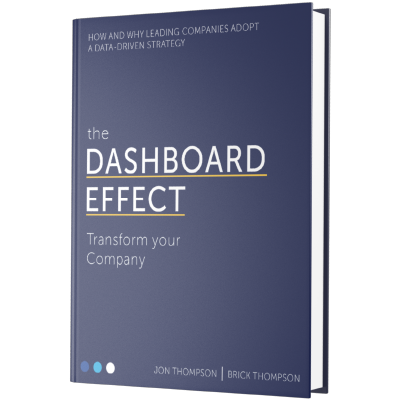As the buzz surrounding AI continues to grow, many mid-market companies find themselves at a crossroads. You have to strike a balance between the dizzying promises offered by tools like ChatGPT and the real ROI they can deliver to your analytics capabilities.
Salesforce’s recent State of Data and Analytics highlighted several imperatives for companies looking to leverage AI, including trustworthy data, effective governance, and strategic implementation. These recommendations are sound, however they don’t address the challenges that mid-market companies like yours face when trying to transform into data-driven enterprises.
The truth is your organization doesn’t need perfect data before catching up to the market with your analytics journey. Instead, you should take a pragmatic, incremental approach that will balance immediate gains with long-term development that builds the momentum you need for lasting change.
Look Beyond the Generative AI Hype
The conversation surrounding the advance of generative AI has executives across industries worried they’re missing opportunities for improvement. CEOs express concern about potentially losing their jobs because they don’t have a robust AI strategy, while simultaneously harboring skepticism about vendors promising transformative results.
This anxiety is understandable, but it’s often misplaced. While generative AI represents an exciting frontier, businesses have been successfully using various forms of AI and machine learning in data analytics for decades. These more established, “traditional” approaches to AI, including regression analysis, optical character recognition, and classification analysis, often provide more immediate ROI than newer generative solutions.
To that end, the surge of interest in ChatGPT and similar tools shouldn’t distract from the value your business can gain from these proven approaches. For many organizations, traditional uses of AI, ML, and predictive analytics will deliver more concrete business value than rushing to implement the latest generative models.
Instead of fixating on cutting-edge generative AI solutions, focus on the business problems you need to solve. Ask what insights would drive measurable improvements in your operations, customer relationships, or financial performance.
Begin Your Analytics Journey with Modern Data Platforms
Any successful analytics or AI initiative starts with a sound foundation. Traditional data warehouses, while useful for structured reporting, create limitations for advanced analytics. They typically involve selecting a subset of fields and tables and storing only what’s needed for predefined reports and dashboards. In effect, you’re reducing the data set and limiting the information that can be extracted from it.
A data lakehouse offers more flexibility for your data scientists. A lakehouse preserves raw data in its original form while also enabling the creation of more structured data models for reporting purposes. Data scientists can access raw data for exploratory analysis, and different teams can transform the same source data to their analytics needs.
By protecting your raw data, the lakehouse model creates a platform that supports your immediate reporting needs as well as future stops on your analytics journey.
Follow the Analytics Ladder: A Practical Framework
Thinking of analytics maturity as a ladder provides a useful framework for progressing your company from basic reporting to insights drawn from advanced AI.
This progression includes four main stages:
- Descriptive Analytics answers the question “What happened?” It includes dashboards and reports illustrating historical performance, trends, and patterns.
- Diagnostic Analytics answers “Why did it happen?” These reports involve more detailed analysis to understand the factors driving performance, often using drill-down capabilities and correlation analysis.
- Predictive Analytics addresses “What could happen?” Using statistical models and machine learning, it forecasts future outcomes based on historical patterns.
- Prescriptive Analytics is the most sophisticated level with systems that indicate “What will happen, and what should we do about it?” Using optimization techniques and advanced AI, your reports recommend actions to achieve desired outcomes
If your company is starting from ground zero, attempting to jump directly to prescriptive analytics is like trying to jump up four rungs of a ladder at once. It’s technically possible but you’re likely to break something.
Instead, master the basics of descriptive and diagnostic analytics before exploring the possibilities of AI. From there, you can adopt a “crawl, walk, run” philosophy of making steady progress up the analytics ladder while continuously improving your data foundation.
Avoid the Data Governance Trap
As the Salesforce report suggests, a strong data foundation is essential to harnessing the potential of digital analytics. But too often, an overemphasis on data quality creates an artificial toll gate companies must cross before doing something with their data.
This seemingly prudent approach can lead to a dangerous cycle of inaction. Companies get excited and initiate data governance programs, hold meetings to discuss data governance, and then lose momentum. The enormity of the task becomes too daunting, and interest dies off because no one is reinforcing the need for data quality by producing outputs.
Perfect Can Be the Enemy of the Good in Data & Analytics
Most organizations have areas where you have good enough data quality to start generating insights while still working on the quality. Rather than viewing data quality as a prerequisite for starting with analytics, consider how analytics can drive improvements.
For example, one manager at a manufacturing firm we started working with advocated for releasing dashboards even when data quality isn’t perfect. From our perspective, he was preaching to the choir. Instead of reserving two people to work on data quality, now he has over a hundred people looking at data and invested in improving data quality.
When people see data in action through custom dashboards, they develop a stronger motivation to address quality issues that affect the results. This approach transforms data quality from an abstract IT initiative into an organization-wide imperative.
Early Wins Build a Data-Driven Culture
Creating a truly data-driven organization requires more than the right technology, it demands cultural change. Your teams need to develop comfort with data, trust in its accuracy, and confidence in their ability to use it effectively.
Early wins play a crucial role in this cultural transformation. When teams see concrete examples of how data can improve decision-making or uncover new opportunities, they become more receptive to incorporating data into their daily work.
These early successes also create a cycle of improvement. As more people engage with data, they identify quality issues, suggest enhancements to reports and dashboards, and propose new use cases. This collective engagement accelerates your analytics journey in ways that a top-down approach rarely achieves.By looking beyond the generative AI hype, your organization can make steady progress toward more sophisticated analytics and AI capabilities. You can’t allow the pursuit of perfection prevent your business from making progress. If you’re ready to get started on the next steps for your business, we should talk.

